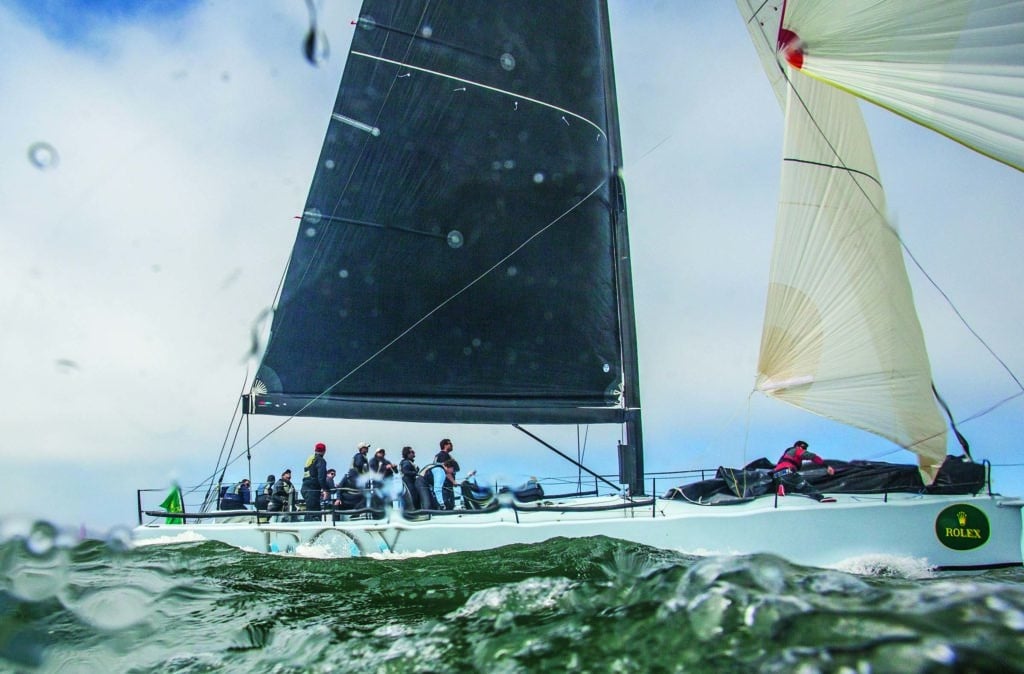
2016 ROLEX BIG BOAT SERIES
The 2017 racing season for Pac 52s will bring the West Coast full circle, with a touch of irony, and it promises to end a drought in high-end keelboat competition in California. We’ll come back to the irony. The new and newly named fleet should have five boats, perhaps six. They’re different from their TP52 cousins in the Mediterranean, but only slightly, and the reasons for that difference match the motivations that were in play when the TP52 class was California-born. It went like this:
In 2000, the success of the Andrews 45 Locomotion sparked a series of events that led the Transpac Yacht Club to develop a new box-rule class. Locomotion was a planing boat that kept pace with 70-footers, and that got the natives excited. Downwind sailing is the heart of the sport in California. The new boats eventually emerged as 52-footers. By name, they were Transpac 52s or TP52s, with characteristics to make them good buoy racers and dynamite ocean racers. The class took off.
Then, by and by, it ran out of steam.
In Europe, meanwhile, a different genetic strain developed, with elite professional crews racing buoy courses only. That too boomed and then faltered, until sweeping rule changes brought the boats up to current standards, with deeper keels, more sail, higher-modulus carbon in the rig, and lighter weight. The class in the Med is set to thrive next season with roughly double the number of boats in the California fleet and dedicated, no-compromise owners.
The California fleet has the dedicated owners in common. Manouch Moshayedi, whose 100-foot Rio in 2016 broke a 12-year-old record in the 2,070-nautical-mile Pacific Cup, San Francisco Bay to Oahu, wants a boat that can race without time allowance. Rio finished first in a five-day crossing, scored last, and still owed the Pac Cup winner (a doublehanded Moore 24) a heap of time. “To win,” Moshayedi says, “we would have had to finish in two days.” Moshayedi is the ringleader for the Pac 52 fleet as it develops, and he takes nothing away from the doublehanded crossing of Mark English and Ian Rogers in their Moore 24. He’s just looking for head-to-head competition.
Versatility is the key to the small differences between Pac 52s and TP52s. Moshayedi explains: “The boats in the Med race windward/leeward only. We want to race windward/leeward, but we want to also race offshore.” That intention places the new California fleet squarely in the tradition of the original fleet of TP52s as envisioned by the Transpac YC for racing to Hawaii and Mexico. “To race offshore, we don’t need as much righting moment to squeeze to a weather mark; we can foot off,” says Moshayedi. Accordingly, the fleet has a lighter motor, to the tune of about 100 kilos. It also has a mast 60 centimeters (not quite 2 feet) higher, so it has more horsepower. Otherwise, the Pac 52 measures to the current standards of TP52s in the Med, which, ironically, inherited their name from West Coast racing, leaving the West Coast folks now to call their boats something else — “Pac 52s,” for example.
That said, the new boats in the West Coast fleet are drawn from the same molds as the fleet in the Med. Moshayedi’s hull follows the Vrolijk-designed Platoon. Invisible Hand and Badpack follow the Vrolijk-designed Provezza.
Victor Wild’s Fox, a winner at the 2016 Rolex Big Boat Series, followed from the design board of Marcelino Botin and Sled. The schedule for 2017 class racing projects three events in Southern California and two on San Francisco Bay — leaving time for a Transpac, of course.









